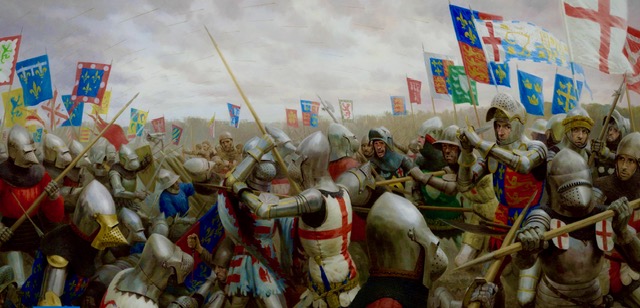REBLOGGED FROM A Medieval Potpourri @sparkypus.com

The Crystal Sceptre. Given by a grateful King Henry V to the City of London in recognition of the financial aid given towards the Battle of Agincourt. Photo The Lord Mayor of London @Twitter.
Some of the eagle eyed amongst you who recently watched the coronation of Charles III may have spotted a very special piece of regalia that was being carried not by the king but by the Lord Mayor of London. This extraordinary and exquisite artefact is known as the Crystal Sceptre and was given to the City of London by a grateful Henry V (b.16 September 1386 – d.31 August 1422) as thanks for the generous financial aid the City gave towards the funding of the Battle of Agincourt fought on the 25 October 1415. It had dawned on Henry in November 1414 – after announcing his plans for a French campaign in Parliament – that the resultant grant, which was to be collected via taxes in two instalments in February 1415 and February 1416, was not going to supply him with the ready cash he desperately needed up front to pay for the army he would be taking to France.
This was obviously a huge stumbling block and problem. What to do? The City of London was known to be a provider of loans in certain circumstances if they could be convinced to do so. Historians Sinclair Rogers and Anne Curry describe in their interesting article how Henry ‘to that end, and following customary practice, sought loans on the security of the tax grants’. However Henry stlll had to somehow persuade the City it was a good idea to agree to the funding. And so on the 10 March 1415 he duly ‘summoned the mayor and aldermen, and some of the more substantial citizens of London to the Tower of London to tell them that he intended to reconquer the possessions of the crown in France and that he needed money:
‘Well-beloved. We do desire that it shall not be concealed from the knowledge of your faithfulness, how that, God our rewarder, we do intend with no small army to visit the parts beyond sea, that so we may duly re-conquer the lands pertaining to the heirship and crown of our realm, and which have been for long, in the times of our predecessors, by enormous wrong withheld. But, seeing that we cannot speedily attain to everything that is necessary in this behalf for the perfecting of our wishes, in order that we may make provision for borrowing a competent sum of money of all the prelates, nobles, lords, cities, boroughs, and substantial men, of our realm, we, knowing that you will be the more ready to incline to our wishes, the more immediately that the purpose of our intention, as aforesaid, redounds to the manifest advantage of the whole realm, have therefore not long since come to the determination to send certain Lords of our Council unto the City aforesaid, to treat with you as to promoting the business before mentioned’ (1).
This astute little speech did the trick and the City offered the king a loan of 10,000 marks which equated to ‘£6,666 13s 4d which is worth almost £2,760,000 today. For security the Bishop of Norwich, Richard Courtney, treasurer of the royal chamber and keeper of the king’s jewels handed over : one great collar of gold, made of workmanship in crowns and beasts called antelopes, enamelled with white esses (i.e. in the style of the Lancastrian SS collar), and the beasts surcharged with green garnets; the charge being of two pearls, and each beast having one pearl about the neck. And each of the crowns is set with one large balass and nine large pearls; and in the principal crown, which is in front, there are set, in addition to the balass and the pearls, two large diamandes in the summit; and besides the crowns, there are other balasses therein, eight in all, the collar weighing 56 ounces in the whole…’ (2).
And so the financial bits taken care of Henry and his army sailed for France on the 12 August 1415.
What happened after that is well documented elsewhere and I won’t touch upon it here but return to the crystal sceptre given in gratitude by Henry. Despite its great historical value it has remained rather a mysterious object that is sadly seldom seen by the general public being only brought out on rare occasions such as coronations – which as we know are very few and far between – and for the ceremonial swearing in of each new Lord Mayor. On a very rare occasion to mark the 600th anniversary of the St Crispin’s Day that fell on the 25 October 1415 it was put on public display in 2015 at the Guildhall Art Gallery from for six weeks. St Crispin’s Day 1415 was of course the day when it is said 9,000 English and Welsh soldiers engaged as many as 36,000 of their French counterparts at Agincourt (3), I have to say I’m not soo sure on the accuracy of these figures but it’s clear to see that the English and Welsh were vastly outnumbered and without this massive loan which paid for men, equipment and particularly the longbow archers who played such a pivotal role in the battle the day may have ended very differently possibly changing the history of England rather drastically. To mark his relief and delight at winning the battle a grateful Henry commissioned the sceptre which was presented to the City of London some time between 1415 and 1421 as a tangible sign of his thanks. .

The Battle of Agincourt. From the painting by Graham Turner.
To continue reading click here.

2 comments